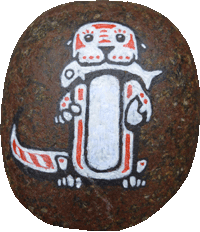7th March 2011
We still haven’t seen a numbat. They’re the only diurnal mammal around here (excepting the noble kangaroo of course) so you’d think it would be easier, but with the small size of these Aussie mammals it’s easier to spot eye-shine in the beam of a torch than spotting a little brown furry thing on the forest floor.
Or we may simply have been nowhere near one, as the caretaker/ranger here at Dryandra says that their numbers have really dropped recently. This seems to be a sadly common cry, with the same being said about the woylies at Perup and all sorts of other critters. At Perup they’ve invested $1M in a predator-proof enclosure where 40 woylies have been trapped and released, while outside their numbers continue to decline. The protected woylies are surviving and breeding happily, but to what end if their natural habitat is still full of these wretched feral predators? Anyway, it sounds like they’ll need to build a similar enclosure for numbats as well soon. Elsewhere in Australia they make use of small offshore islands with suitable habitat; it’s easy to ensure no predators exist on an island, and so these also become little protected communities of marsupials who can no longer survive in their mainland habitats.
It’s all very sad. Elsewhere in the world where habitat destruction or human hunting has brought an animal close to extinction you can try and rebuild habitat and educate the people. Otters in the UK are a nicely local example of this: captive breeding programs were vital in the 70’s and 80’s for just keeping the species going, but by the end of the 90’s Britain’s rivers had been wonderfully cleaned up, the most dangerous agricultural chemicals banned, otter hunting a thing of the past, and now there are stable populations of wild otters in almost all counties.
Feral predators and invasive species like the cane toad are a different matter. You can restore the habitat to a pristine state, ensure everyone cares for their native wildlife, and yet the species will still die out unless you can find an effective way to eradicate the invasives. The 1080 program works well on foxes, but it’s a program with no end in sight. Eradicate all the foxes from a territory and you just make space for young foxes from other areas to migrate into; you’d have to 1080-bait the whole of Australia for years to eradicate them all. And they haven’t even come up with an effective poison for the feral cats, which I have a sneaking suspicion may be the worst culprit for small animals like numbats.
And here’s me thinking “dratted numbat” for not being good enough to make itself visible for photographing while we’re here for a couple of days. Perspective, dude.
Related Images:













































